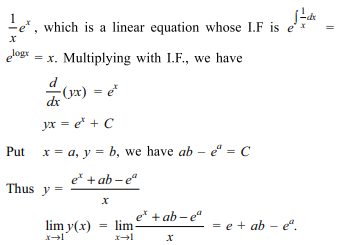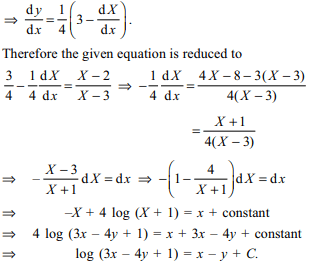1. The area of a triangle formed by the
tangent to a curve and coordinate axes is constant say
K. The degree of the differential equation is
a) 2
b) 1
c) 3
d) 4
Explanation: Let the curve be y = f(x). Equation of tangent

2. A curve passing thought (4,5) and sataisfying the integral equation \[\int_{0}^{x} ty\left(t\right)dt=x^{2} y\]
is
a) \[x^{2}+ y^{2}=41\]
b) \[ y^{2}=\frac{25}{4}x\]
c) \[\frac{x^{2}}{32}+\frac{y^{2}}{50}=1\]
d) xy = 20
Explanation:

3. Consider \[\frac{dy}{dx}=\frac{2\cos 2x}{3+2y}\] , y(0) = –1. The
value of x for which y is maximum is
a) \[\frac{\pi}{2}\]
b) \[\frac{\pi}{3}\]
c) \[\frac{\pi}{4}\]
d) 2
Explanation: (3 + 2y)dy = 2cos 2x dx

4. Let f be a differential function with
\[\lim_{x \rightarrow \infty}f\left(x\right)=0\]
If y + y f'(x) – f (x) f '(x)=0 , \[\lim_{x \rightarrow \infty}y\left(x\right)=0\]
then
a) \[y+1=e^{f\left(x\right)}+f\left(x\right)\]
b) \[y+1=e^{-f\left(x\right)}+f\left(x\right)\]
c) \[y+2=2e^{-f\left(x\right)}+f\left(x\right)\]
d) \[y-1=-e^{-f\left(x\right)}+f\left(x\right)\]
Explanation: y' + y f'(x) – f(x) f'(x) = 0 is a linear equation with integrating factor

5. If \[xy'+y-e^{x}=0,y\left(a\right)=b\]
then
a) \[\lim_{x \rightarrow 1}y\left(x\right)=e+2ab-e^{a}\]
b) \[\lim_{x \rightarrow 1}y\left(x\right)=e^{2}+ab-e^{-a}\]
c) \[\lim_{x \rightarrow 1}y\left(x\right)=e-ab-e^{a}\]
d) \[\lim_{x \rightarrow 1}y\left(x\right)=e+ab-e^{a}\]
Explanation:


6. The equation to the curve which is such
that portion of the axis of x cut off between the origin and
the tangent at any point is proportional to the ordinate of
that point is
a) x = y (C – K log y)
b) \[\log x = Ky^{2} + C\]
c) \[x^{2}=y\left(C-K\log y\right)\]
d) \[\log y=Kx^{2}+C\]
Explanation: Let the curve be y = f(x). The equation of tangent at any point (x,y) is given by Y – y = f'(x) (X – x). So the portion of the axis of x which is cut off between the origin and the tangent at any point is obtained by putting Y = 0. Therefore,

7. The solution of the equation \[\frac{dy}{dx}=\frac{3x-4y-2}{3x-4y-3}\]
is
a) \[\left(x-y\right)^{2}+C=\log\left(3x-4y+1\right)\]
b) x – y + C = log (3x – 4y + 4)
c) x – y + C = log (3x – 4y – 3)
d) x – y + C = log (3x – 4y + 1)
Explanation:


8. The differential equation of all parabolas
with axis parallel to the axis of y is
a) \[y_{2}=2y_{1}+x\]
b) \[y_{3}=2y_{1}\]
c) \[y_2^3=y_{1}\]
d) \[y_{3}=0\]
Explanation: Let (u v) be the vertex of the parabola. The equation of the required parabolas are of the form (x – u)2 = A( y – v). There are three unknown constants Differentiating successively three times we have 2(x – u) = Ay1; 2 = Ay2 and y3 = 0.
9. The differential equation of all ellipses
centred at the origin is
a) \[y^{2}+xy_1^2-yy_{1}=0\]
b) \[xyy_{2}+xy_1^2-yy_{1}=0\]
c) \[yy_{2}+xy_1^2-xy_{1}=0\]
d) \[xy_{2}+xy_1^2-yy_{1}=0\]
Explanation: Ellipses centred at origin are given by

10. The solution of the differential equation
\[\frac{d^{2}y}{dx^{2}}=\sin3x+e^{x}+x^{2}\]
when \[y_{1}\left(0\right)=1\] and
\[y\left(0\right)=0\] is
a) \[\frac{-\sin 3x}{9}+e^{x}+\frac{x^{4}}{12}+\frac{1}{3}x-1\]
b) \[\frac{-\sin 3x}{9}+e^{x}+\frac{x^{4}}{12}+\frac{1}{3}x\]
c) \[\frac{-\cos 3x}{3}+e^{x}+\frac{x^{4}}{12}+\frac{1}{3}x+1\]
d) \[\frac{\sin 3x}{9}+e^{x}+\frac{x^{4}}{4}+\frac{1}{3}x^2-1\]
Explanation: Integrating the given differential equation, we have
